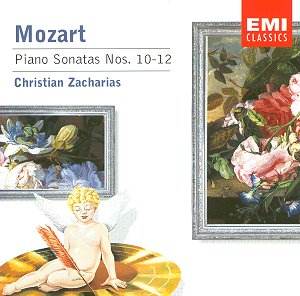These three sonatas date from the early years of the 1780s, soon after
he had settled in Vienna, a time when Mozart was particularly conscious
of his pianistic virtuosity, having decided to spread his wings beyond
the confines of Salzburg. One result of these preoccupations is the
distinctive personality accorded to each composition, and this is one
of the challenges which every pianist has to consider.
Christian Zacharias recorded these sonatas in 1984 and 1985, and it
needs be said straight away that the EMI engineers responded to the
project with some exceptionally fine piano sound. The instrument is
not a period fortepiano but rather a modern grand, thought he accompanying
documentation does not give us the exact details. Nor does it give us
a lot else, beyond perpetuating the misleading myth that Mozart was
buried in a pauper's grave.
Zacharias has the great merit of tightly focused rhythmic control,
which stands him in good stead in the outer movements of the C major
Sonata, K330, for example. Likewise his phrasing of slow movements can
be sensitive, and the Andante cantabile of this same Sonata makes the
whole piece the most successful of these three performances. The F major
work, K332, also gains from some nicely judged tempi and clearly articulated
accenting.
What is less successful here is the best known of the three sonatas,
and the most unusual of them. The A major Sonata, K331, begins with
an extended theme-and-variations movement which sets a real challenge
of concentration, if the ideal of unity combining with variety is to
be achieved. Zacharias does not really sustain the tensions across the
whole span of this special movement, though things do improve in the
Minuet which follows. What is most problematic of all, however, is the
famous 'Turkish Rondo' finale, in which the rhythmic accents are emphasised
with additional and undue percussive effects. Again one looks in vain
for documentary justification of this extravagance; so without it, this
reviewer feels inclined to describe it as ill-judged, and a lapse of
taste.
Terry Barfoot


